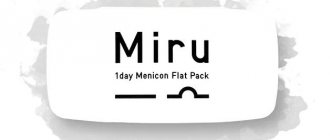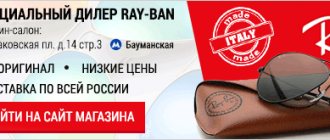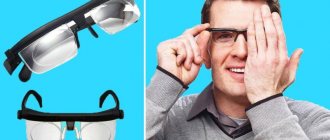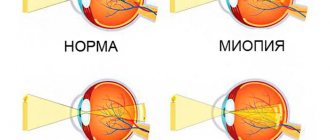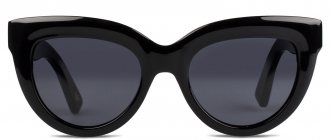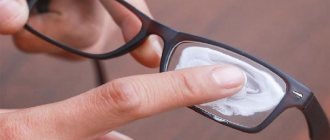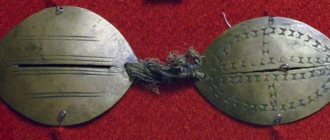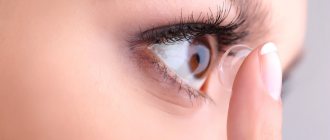Glasses are an important part in correcting human vision. Therefore, the choice of optics should be approached responsibly. First of all, you need to visit an ophthalmologist who will conduct a comprehensive examination and prescribe glasses. After this you can order glasses. In this case, you should take into account the material from which the lenses will be made. After all, now, in addition to glass, organic polymers are used for manufacturing.
Benefits of chameleon glasses
- There is no need to buy two accessories - they can replace both eyeglasses and sunglasses.
- Adaptability – depending on weather conditions, the degree of transparency of the optics changes, making the eyes comfortable in any weather, while protection from ultraviolet radiation is always at a decent level.
- A large number of design types and varied designs allow you to choose an accessory depending on the buyer’s preferences.
- They can be used not only by healthy people, but also by those who have various visual impairments.
Disadvantages of chameleon glasses
It’s worth noting right away that all the shortcomings that will be listed below apply only to products that are manufactured using outdated technologies. Currently, most of them are irrelevant; the only disadvantage of such accessories is the high price per unit. Flaws:
- Long time to change the lighting mode.
- Difficulties when working in conditions of elevated ambient temperatures.
- Uneven dimming in different areas, this is especially true for cheap products.
- Inaccessible to wear while driving, since car glass does not transmit ultraviolet rays.
- A small number of color options - most often, models with green and brown shades are found on sale.
When choosing photochromic optics, consultation with an ophthalmologist is required.
Spectacle lenses for varying degrees of ametropia
When selecting lenses, it is necessary to take into account the refractive index of the material.
The refractive index is the ratio of the speed of light in a vacuum to the speed of light in the optical material of the lens. The refractive index largely depends on the structure of the material. Optical materials may have:
- normal refractive index;
- average refractive index;
- high refractive index;
- ultra-high refractive index.
For different degrees of ametropia, materials with different refractive indices are used:
- For mild ametropia, lenses made from a material with a normal refractive index are used.
- To correct the average degree of ametropia, materials with an average refractive index are used;
- High degree of ametropia is corrected using lenses made of material with a high and ultra-high refractive index.
What to look for when choosing chameleons
The main criteria for choosing glasses with photochromic optics are:
- Material of manufacture. Optics are made of glass or plastic, each of these materials has a specific set of characteristics. Glass is more affordable and has a longer service life, but it has limited functionality - it is afraid of mechanical influences (breaks from impacts from a hard body), has more weight than its plastic counterpart, darkens unevenly, has a longer darkening period, and certain difficulties may arise when selecting frames , since not everyone will fit. Plastic products are lightweight, resistant to mechanical stress (difficult to break, which is why they are often purchased for children), uniform darkening, and are suitable for any type of frame. Among the disadvantages, one can highlight the fact that high-quality models are more expensive in price than glass ones, if treated carelessly, they scratch faster and are short-lived.
- The degree and rate of change in light transmission. Transparency (the ability to transmit sunlight) is determined by an indicator called the minimum degree of shading. There are three categories - completely transparent (0%), with an average degree of tint (2-5%), highly tinted (6% or more). The maximum darkness level indicates how dark the optics can become. There are two categories - up to 50% - slightly darkened, 50% or more - highly darkened. The change in light transmission depends on the quality and manufacturing technology - the more modern the model, the faster it darkens. The speed of color change ranges from 1 to 5-6 minutes.
- Use when vision correction is necessary. Models come with or without this function.
- Quality UV protection. Not all models have UV protection. When purchasing, it is recommended to pay attention to the characteristics of the glasses; the level of protection is expressed as a percentage, the best value is 100%. Some models are not able to completely protect the eyes from harmful radiation, and therefore they are suitable only for short-term wearing in sunny weather.
- A method for determining the required degree of darkness. There are 2 main technologies. The first reacts to the physical presence of ultraviolet rays on the surface of the lenses. Accessories made using this method are not suitable for drivers, since due to the fact that the windshield blocks UV rays, the optics are not darkened. The second, advanced technology, evaluates the length of the beam and is able to react to ultraviolet radiation even without it physically hitting the glass. These are the accessories that are necessary for comfortable driving for those who spend a lot of time behind the wheel of a car.
- Scope of application. According to the recommendations of ophthalmologists, before purchasing it is worth assessing why you will need chameleons. If you plan to spend most of your time indoors, you need to choose models that have maximum transparency. Drivers, as mentioned earlier, should choose glasses that “see” the ultraviolet light inside the car. For those who engage in various outdoor activities (athletes), you need to choose models with a high color change rate. For people who spend most of their time outdoors, you need to choose chameleons with maximum darkness.
How to choose quality corrective glasses
Vision correction products are ubiquitous today. Such products can be purchased even in markets, but how high quality will such an acquisition be?
Many people with vision problems have no idea about corrective glasses. Therefore, if the need arises to purchase such a product, people often act rashly and purchase low-quality goods .
Subsequently, a person may experience a number of negative consequences from such an acquisition:
- Pain and pain in the eyes.
- Continued decrease in vision.
- Skin irritation leading to an allergic reaction caused by poor-quality materials in the manufacture of frames.
- The inharmonious appearance of glasses on the face of its owner. In very rare cases, street vendors can choose the right frame for a client.
Rating of popular photochromic lens models
Price category up to 5,000 rubles
When purchasing a product in this price category, it is worth considering that the quality of the optics will not be at the highest level, but it is capable of performing basic functions.
BBGR Transitions VII Signature
The country of manufacture of the product is France. This is already the seventh generation of optics, which was developed taking into account all the operating features of its predecessors. The main drawback of the previous model has been eliminated - at high ambient temperatures, photochromic technology practically did not work, color changes were carried out slowly. The model is intended for everyday wear and has a wide range of color variations.
According to buyers, the product combines both darkening and brightening properties well - the glass becomes completely transparent indoors, and dark enough outdoors to protect the eyes from bright colors. According to customer reviews, glasses with chameleons from this manufacturer can be used not only in the office (transparency up to 5%), but also when driving - visibility is not limited, and when exposed to sunlight, the degree of darkness corresponds to the third category of sunglasses.
The manufacturer states that modern technology was used in production, which includes 8 different pigments, which contain a large number of molecules that provide color changes. You can choose from 18 colors, not only standard shades, but also individual ones. The average price of a product is 3,000 rubles.
BBGR Transitions VII Signature
Advantages:
- budget price;
- completely transparent indoors;
- many coating colors to choose from;
- quickly respond to changes in lighting.
Flaws:
- With careless use, small scratches appear on the surface.
Shamir Altolite 1.5 Transitions XTRActive Gray HMC
Country of origin: Israel. The product is made of polymer material, which has a number of advantages compared to glass analogues - light weight, elasticity (due to which it can be used in any frames), etc. Compared to competitors, this model has the ability to darken even when used in a car, which is important for drivers. This possibility is realized through the use of a special coating that reacts to ultrashort light rays.
According to the manufacturer, its optics are the darkest in the world, since in bright sunlight the degree of dimming is 90% (despite loud statements, it should be noted that this figure is achieved only at an ambient temperature of no more than 23 degrees, and at elevated readings - the maximum value is 80%). The minimum value indoors is 12%, which is why some buyers complain about poor visibility. The darkness inside the car does not exceed 50%.
First of all, this product is intended for those who spend a lot of time outdoors and want to protect their eyesight from solar activity. These are the best lenses with UV protection - the protection level is 100%. The product is sold only in gray, there is no choice of other colors. The surface of the product is coated with a hardening compound that prevents the appearance of small scratches. The product with diopters is intended for those who need vision correction - most often it is prescribed to people with myopia and hypermetropia. The product is intended for use with rimless glasses and is not recommended for use with rimless or rimless frames. The average price of a product is 4,200 rubles.
Shamir Altolite 1.5 Transitions XTRActive Gray HMC
Advantages:
- the highest dimming parameters;
- suitable for drivers;
- inexpensive optics;
- Buyers do not have any difficulties with where to buy the model - it can be ordered online in any specialized online store;
- high degree of protection against UV rays;
- There is a protective coating against damage.
Flaws:
- Suitable for rim frames only;
- low transparency in the room;
- Available in one color only.
Rodenstock Perfalit 1.54 ColorMatic
Country of origin: Germany. Like other competitors' products, this product is made of polymer material. The product represents good value for money. Compared to glass competitors, the darkness is uniform throughout the lens. There are two colors to choose from – warm (brown) and cool (gray). The first is distinguished by high contrast, and the second by realistic colors. Gradation of light transmission - from 8% to 85% (at ambient temperatures above 23 degrees, the value decreases). A product with an antireflective coating is intended for indoor use, with multifunctional (hydrophobic, antistatic, dust and dirt resistant) - providing protection from external influences.
According to the manufacturer, this model is the fastest among competitors in terms of the speed of change in light transmission (contrast changes within 10-15 seconds). Suitable for use by drivers, it protects against glare from the headlights of oncoming vehicles. Can be worn when working with a computer. Recommended for installation in screw and line frames. The refractive index is 1.54, which makes the model thicker than some competitors. The average price of goods is 3,300 rubles.
Rodenstock Perfalit 1.54 ColorMatic
Advantages:
- rapid color change;
- high-quality coating;
- 100% protects against ultraviolet light;
- the optics in the room become completely transparent;
- low cost.
Flaws:
- small diopter range (from -6 to +4).
Price category from 5,000 to 10,000 rubles
Nikon Transitions
The well-known manufacturer of photography products presented a new product in the field of health optics. The country of origin of the product is Japan. The lenses are designed for everyday wear. As in the model that occupies the top of the rating in the price category up to 5,000 rubles, it uses Chromea 7 technology, in which the optics coating consists of 8 pigments that change color when exposed to sunlight.
According to the manufacturer, the model protects the eyes 100% from sunlight. Thanks to the low darkness threshold, the optics become completely transparent indoors. There are three color options to choose from - brown (designed for those who require maximum contrast), gray-green (best color rendition) and gray (realistic colors). According to research conducted by the manufacturer, the majority of buyers (90%) who once bought optics buy them again. A product with diopters is intended only for those who have vision problems; healthy people are not recommended to buy such a product. The average price of a product is 7,500 rubles.
Nikon Transitions
Advantages:
- transparent indoors and dark outdoors (protects eyes from ultraviolet radiation by 100%);
- quality technology;
- a large number of positive customer reviews;
- react not only to direct light, but also to side light.
Flaws:
- small selection of colors.
Top Vision ASP 1.67 Transitions XTRActive HMC
The review continues with a Russian-made product. It is made of polymer and has high quality indicators. The optics are manufactured from blanks that are sourced from the USA and are subject to minimal processing. In the model under consideration, the highest refractive index is 1.67. There are three colors to choose from – brown, gray and green. Indoors, all three types of chameleons become almost transparent, and block only 5% of light.
According to the description on the manufacturer's website, the product does not transmit blue spectrum rays that come from a computer monitor, as well as artificial lighting sources. The color changes to the dark side in 1 minute, to the light side in 10. The optics provide complete protection from ultraviolet radiation. The product is offered with two types of coating - with and without anti-reflective coating. The coating is also able to repel water and dirt, including dust (antistatic properties). Resistant to mechanical damage, is plastic and not subject to cracking. Since the product reacts to the entire spectrum of radiation, chameleons are able to darken in the car, which is important for drivers. The range of compatible diopters is from -10 to +8. Buyers note the thinness of the product, since it is single vision. One of the disadvantages is the high initial darkness (11%), which makes the glasses look dark even indoors. The cost of the product is 9,000 rubles.
Top Vision ASP 1.67 Transitions XTRActive HMC
Advantages:
- large range of applicable diopters;
- high-quality coating;
- thin walls of optics.
Flaws:
- one of the most expensive Russian models that are on sale;
- a small number of glass colors;
- high initial darkness.
Carl Zeiss 1.6 AS PhotoFusion
The review continues with another German-made product, which is an aspherical lens. According to customer reviews, this optics dims quickly, within a few seconds. Enlightenment occurs more slowly, over several minutes. The speed of brightening depends on how much they were darkened. The light transmission range ranges from 9% to 23%. The refractive index of the rays is 1.6, which indicates the small thickness of the optics.
The product is intended for use with glasses without a rim or with a line mount. This feature is due to the material used to make the product, which has high ductility. The popularity of the models from this manufacturer is due to the high quality, which is also present in this product - users note wear resistance and resistance to mechanical damage. The aspherical shape avoids image distortion that is present in most standard glasses. Anti-reflective polymer technology ensures comfortable wearing of glasses in any environment. In the manufacture of the product, technology was used that provides oleophobic and hydrophobic functions, so that the glasses do not require special care during operation.
There are two colors to choose from – brown and grey. The first provides high contrast, and the second provides natural color reproduction. Chameleons provide 100% UV protection. The product is manufactured in three different diameters - 65, 70, 75. As buyers note, even with a high diopter value, the optics have an attractive appearance. The polymer itself is manufactured using modern technology, which allows the product to be formed 25% thinner than analogues with comparable parameters. The average price of goods is 7,500 rubles.
Carl Zeiss 1.6 AS PhotoFusion
Advantages:
- multifunctional coating that provides protection from dust, moisture, and mechanical damage;
- there is no distorting effect at the edges of the lens;
- oleophobic coating prevents the formation of greasy fingerprints on the optics;
- chameleons are thin compared to their analogues;
- a large number of positive customer reviews;
- smooth transition between light levels.
Flaws:
- small number of colors to choose from;
- According to customer advice, you should take care of purchasing such chameleons in advance, since in most stores they are sold only to order.
Price category over 10,000 rubles
Seiko CURVED X 1.67 Transitions BC6/BC4
This product from a well-known Japanese brand is made using technology that allows plastic to be bent in such a way as to eliminate poor visibility at the edges and provide a natural view. The product is intended for installation in frames that have a non-standard shape and are characterized by a high base curvature. Can also be used with sports glasses.
Unlike previous models, this lens can be configured to order a large number of parameters: base material, type of coating, presence of polarization, color. The standard coating consists of 16 layers, each of which performs its own function - protection from mechanical influences, lightening, dust and dirt protection, antistatic, polarization properties. At the request of the client, it is possible to apply a mirror coating, which makes the surface opaque. There are 5 colors to choose from - gold, silver, blue, green, red.
There are also 2 proprietary finishes: Seiko SRC and SRB. The first is distinguished by increased strength and antistatic characteristics - according to the advice of oculists, it is suitable for those buyers who handle glasses carelessly (scratches do not appear even when worn without a case). The second coating blocks the blue light that comes from gadget screens. It is suitable for those who, due to the nature of their work, spend a lot of time on a computer, mobile phone or tablet.
In the case of custom-made lenses, some parameters can be selected depending on the client’s preferences - the use of additional coating, adjusting the diameter of the product, changing the thickness, reducing the prism, manufacturing in a certain style, etc. Lenses can be monofocal or bifocal. The average unit price is 17,700 rubles.
Seiko CURVED X 1.67 Transitions BC6/BC4
Advantages:
- individual production according to the required parameters;
- high quality materials;
- a large number of positive customer reviews.
Flaws:
- many buyers complain about how much the product costs - for 2 lenses you will have to pay more than 30,000 rubles;
- long production time (up to 20 working days).
HOYA DriveWear Hi-Vision Aqua 1.5
As is clear from the name of the product, its main purpose is for use by drivers, and therefore, it has a distinctive ability to react to sunlight, despite the protective properties of the windshield. Chameleons have a polarizing coating, which performed well not only in sunny but also in cloudy weather.
The development of the Japanese company has been awarded a large number of different awards and prizes, which is associated with a set of characteristics that combine not only an attractive design, but also high-quality materials, durability and ease of use. Japanese quality, honed over more than fifty years of history, is noted not only by ophthalmologists, but also by buyers of these products.
The brand's products are manufactured at the factory in a full cycle mode, which allows them to achieve high performance characteristics. The range of offered diopters is from -8 to +6. There are three diameters to choose from - 65, 69, 71. To ensure resistance to external factors, a coating is used that has a water-repellent, anti-reflective, and anti-reflective effect. At the buyer's request, its type can be selected individually from a large list of items. Users note the comfort on the eyes, stylish design and soft greenish color of the lenses indoors. The initial shade is green-yellow, and with changing lighting it turns into dark brown. The average price of goods is 14,500 rubles.
HOYA DriveWear Hi-Vision Aqua 1.5
Advantages:
- attractive appearance;
- wide choice of coatings;
- belong to the category of branded lenses;
- Can be used while driving a car.
Flaws:
- high price;
- not transparent indoors, which some users do not like;
- difficult to find in stock in stores.
Younger Optics Drivewear Polycarbonate UV
The review continues with another representative of chameleons for drivers, this time made in America. According to the description on the manufacturer's website, the lenses darken in three stages - in low light, in cloudy weather they acquire a yellow-green color and retain 65% of light, in a car in sunny weather they become copper-colored (retain 78% of rays), in bright weather sun - brown (88%).
The product is designed for installation in a rim frame, has a spherical shape, and is made of polycarbonate. The lenses do not become completely transparent indoors, but the greenish tint allows you to enhance the contrast of the surrounding environment. 100% protected from ultraviolet rays. The product is made by combining two advanced technologies – Transitions and polarization. Thanks to this, the user's eyes are protected not only from the bright sun, but also from the glare of the headlights of oncoming cars. It is not recommended to use chameleons at night, as they can behave unpredictably if there is a sudden change in light.
Ophthalmologists recommend these lenses not only because they perform well in any outdoor weather, but also because the product is made of polycarbonate, which has high impact resistance, less weight, plasticity and an attractive appearance. The following diameters are available to choose from - 55, 65, 70, 72. Diopter range - from - 08 to 4. The average price of the product is 10,500 rubles.
Younger Optics Drivewear Polycarbonate UV
Advantages:
- attractive appearance;
- can be used when driving a car;
- rapid change in darkness;
- Modern technologies were used in production.
Flaws:
- high price;
- Suitable for rim frames only.
Spectacle lenses for different types of ametropia
The main purpose of the lens for ametropia is to move the focus of the image to the retina of the eye, due to which visual acuity increases and the perception of surrounding objects seems clear.
Each type of ametropia has its own characteristic features of the projection of light rays onto the retina. Therefore, different spectacle lenses are used for correction.
According to their optical effect, lenses are divided into:
- stigmatic (spherical);
- astigmatic;
- prismatic;
- eikonic (afocal);
Stigmatic and astigmatic lenses according to the position of the main focus are divided into:
- collecting (plus);
- scattering (negative).
To correct myopia, concave (diverging) lenses are used. This type of lens is thin in the center and thickens towards the edges. The curvature, thickness and weight of these lenses depends on the degree of myopia.
Farsighted people are prescribed glasses with converging (plus) lenses. These lenses have a convex shape.
Based on the number of optical zones, lenses are divided into:
- single vision;
- multifocal.
In some cases, glasses with bifocal lenses are prescribed for hypermetropia. The peculiarity of these lenses is that they are divided into two parts, which have different optical powers. The top half of these lenses allows you to see objects at a distance, while the bottom half allows you to see objects up close.
Single vision lenses have only one optical correction zone, intended for distance vision or near vision. With the help of such lenses, presbyopia (senile farsightedness) is corrected. Typically, plus single vision lenses are used only for near vision. Their optical power varies from 0.50 to 3.00 diopters.
Correction of distance and near vision is carried out using bifocal, trifocal, and progressive lenses. These lenses have zones of different refraction and are designed to simultaneously correct vision at different distances. Progressive lenses for glasses differ from bifocal lenses in a smooth transition of refraction, which provides greater comfort when wearing them. They are the most modern option for correcting presbyopia.
To correct astigmatism, special cylindrical lenses are used.
If astigmatism is accompanied by myopia or hypermetropia, converging and diverging lenses are additionally used. Important indicators when prescribing spectacle lenses to correct astigmatism are data on the cylinder and the position of its axes.
Progressive lenses for glasses
